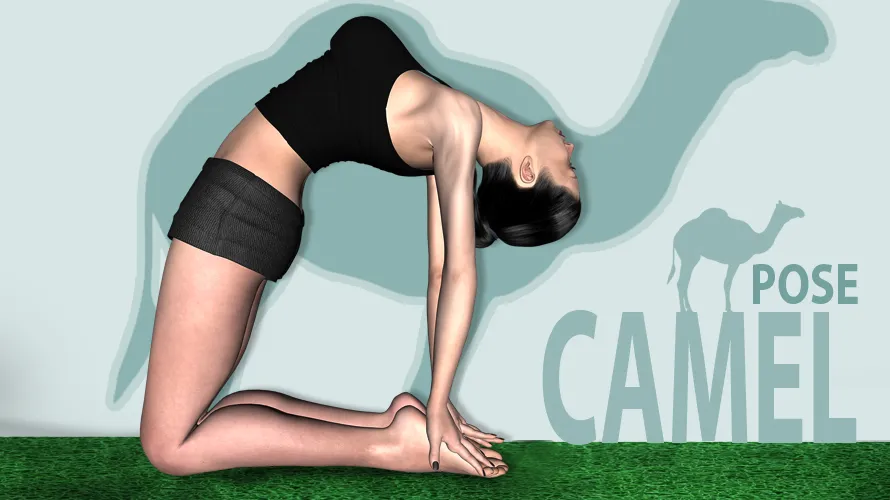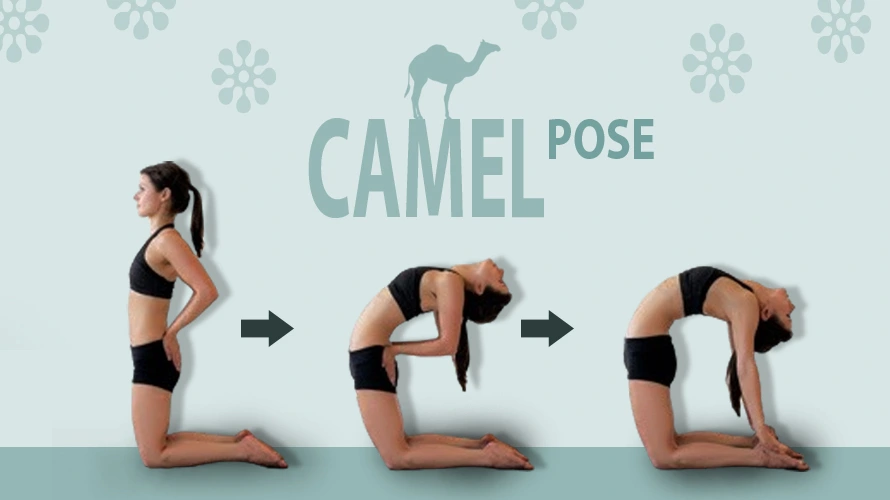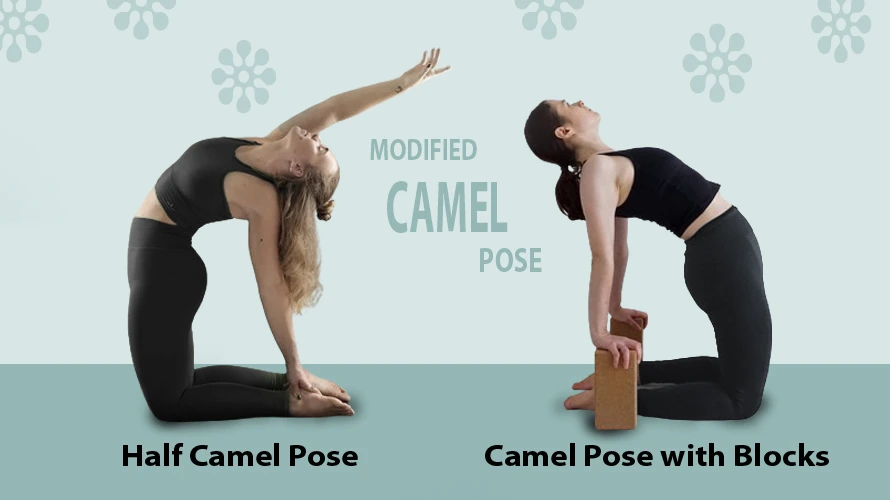This detailed guide on Camel Pose Ustrasana explores the key aspects of this heart-opening backbend, offering step-by-step instructions, variations, and insights into its significance in yoga practice.

Before diving into the details of the Camel Pose (Ustrasana), it’s helpful to first understand the basics of yoga and its key aspects.
Yoga is a holistic practice that originated in ancient India, combining physical postures, breathing exercises, meditation, and ethical principles to promote overall well-being. The word “yoga” comes from the Sanskrit root “yuj,” meaning to unite or join, symbolizing the union of body, mind, and spirit.
Key Aspects of Yoga:
- Physical Postures (Asanas): These are designed to improve flexibility, strength, and balance. Common poses include Downward Dog, Warrior, and Tree Pose.
- Breathing Techniques (Pranayama): Controlled breathing exercises help to regulate energy and calm the mind.
- Meditation (Dhyana): Aims to focus the mind and develop a deeper sense of awareness and mindfulness.
- Ethical Guidelines: Yoga also emphasizes moral and ethical conduct, including principles like non-violence (Ahimsa) and truthfulness (Satya).
- Benefits: Regular yoga practice can improve physical health, reduce stress, enhance mental clarity, and promote emotional balance.
Yoga can be tailored to suit individuals of all ages and fitness levels, making it a versatile and accessible practice for everyone.
Camel Pose (Ustrasana)
The Camel Yoga Pose, known as Ustrasana in Sanskrit, is a deep backbend that emphasizes the opening of the chest and stretching of the entire front body. In this posture, the practitioner kneels on the mat with their knees hip-width apart, while the hands reach back to grasp the heels. The head and spine arch backward, creating a graceful curve that resembles the hump of a camel. This pose requires a careful balance of strength and flexibility, as the practitioner must engage their core and thighs to support the backbend, while simultaneously expanding the chest and shoulders to create the full expression of the pose. It’s a posture that invites mindfulness and a deep connection to one’s breath as the body moves into a state of openness and expansion. Here’s a comprehensive look at this yoga pose:
How to Perform Camel Pose (Ustrasana)

- Starting Position: Begin by kneeling on the floor with your knees hip-width apart. Place your hands on your hips with your fingers pointing downwards.
- Preparation: Ensure your thighs are perpendicular to the floor and your hips are aligned directly over your knees. Keep your shins and tops of your feet pressed firmly against the mat.
- Engage Core: Engage your core muscles to support your lower back and maintain stability throughout the pose.
- Reach Back: Slowly start to arch your back, lifting your chest towards the ceiling. As you do this, gently reach your hands back to grasp your heels. If you cannot reach your heels comfortably, you can tuck your toes under to elevate your heels.
- Open Chest: Push your hips forward, so they remain over your knees. Open your chest and allow your head to drop back, keeping your neck relaxed.
- Hold the Pose: Hold the pose for 20 to 30 seconds, breathing deeply. Focus on lifting your chest and stretching the front of your body rather than compressing your lower back.
- Release: To release the pose, bring your hands back to your hips, and slowly lift your torso back up to a kneeling position. Sit back on your heels and rest for a few breaths.
Benefits of Camel Pose Ustrasana
- Spinal Flexibility: Improves the flexibility and strength of the spine, which can help alleviate back pain and improve posture.
- Chest and Shoulder Stretch: Stretches the chest, shoulders, and abdomen, which can help open up the respiratory system and increase lung capacity.
- Hip Flexor Stretch: Provides a deep stretch for the hip flexors, which can be particularly beneficial for those who spend long periods sitting.
- Emotional Release: Backbends are often associated with emotional release, as they open up the heart chakra, potentially helping to release stored emotions and stress.
- Improved Digestion: Stimulates the abdominal organs, which can aid in digestion and improve overall gut health.
- Energy Boost: Ustrasana can help energize the body and combat fatigue by stimulating the adrenal glands and increasing blood flow.
Modifications and Variations

- Half Camel Pose: If reaching for the heels is too intense, you can perform a modified version by keeping one hand on your lower back while reaching for one heel with the other hand. Switch sides after a few breaths.
- Blocks: Use yoga blocks placed on either side of your feet to rest your hands on if you cannot comfortably reach your heels.
- Gentle Approach: Beginners can keep their toes tucked under to elevate the heels and make them easier to reach. This can help in maintaining balance and reducing strain on the lower back.
Precautions
- Back Issues: Avoid this pose if you have serious back or neck issues, unless practicing under the guidance of a qualified yoga instructor.
- High or Low Blood Pressure: Individuals with high or low blood pressure should exercise caution or consult with a healthcare professional before attempting this pose.
- Migraine or Insomnia: Those suffering from migraine or insomnia should avoid deep backbends, as they can exacerbate symptoms.
- Knee Problems: If you have knee problems, place a folded blanket under your knees for cushioning and support.
Camel Pose (Ustrasana) is a powerful and invigorating posture that offers numerous physical and emotional benefits. Practicing it mindfully and with proper alignment can help you reap its rewards while minimizing the risk of injury.
Fun Facts and Interesting Details about Camel Pose
Here are some fun facts and interesting details associated with the Camel Pose (Ustrasana) in yoga:
- Name Origin: The name “Ustrasana” comes from the Sanskrit words “ustra” meaning camel, and “asana” meaning pose. The pose is said to resemble the hump of a camel when performed correctly.
- Heart Chakra Opener: Ustrasana is considered a powerful heart-opening pose in yoga. It is believed to stimulate the heart chakra (Anahata), promoting feelings of love, compassion, and emotional balance.
- Therapeutic Benefits: Camel Pose is often recommended for those dealing with respiratory issues, as the deep chest opening can help improve lung capacity and relieve mild asthma.
- Emotional Release: Backbends like Camel Pose can lead to an emotional release. As the chest opens and the heart area is exposed, some practitioners may experience a release of pent-up emotions, sometimes even leading to crying or feelings of intense joy.
- Counterbalance to Forward Bends: Camel Pose serves as an excellent counterbalance to forward bends and seated postures. If you spend a lot of time sitting or working at a desk, this pose can help stretch the front of your body and counteract the effects of hunching forward.
- Improved Posture: Regular practice of Camel Pose can help improve posture by strengthening the muscles of the back and shoulders, making it easier to stand and sit upright with less effort.
- Historical Significance: In traditional Hatha yoga, Ustrasana is often included in sequences to prepare the body for deeper backbends and more advanced postures, indicating its importance in building flexibility and strength.
- Mental Clarity: Practicing Camel Pose can help clear mental fog and improve concentration. The intense opening of the chest and heart area is believed to stimulate the flow of energy, enhancing mental clarity and focus.
- Variation in Styles: Different styles of yoga may have slight variations in how Camel Pose is practiced. For example, in Bikram yoga, Camel Pose is performed in a heated room and held for a longer duration, while in Vinyasa yoga, it might be included as part of a dynamic flow.
- Symbolism: The camel is a symbol of resilience and endurance in many cultures, which can be metaphorically linked to the benefits of Ustrasana in building mental and physical strength.
- Chakra Association: Beyond the heart chakra, Ustrasana also stimulates the throat chakra (Vishuddha), which is associated with communication and self-expression. This makes it a beneficial pose for those looking to enhance their communication skills and express themselves more authentically.
- Preparation for Deeper Backbends: Ustrasana is an excellent preparatory pose for more advanced backbends like Wheel Pose (Urdhva Dhanurasana) or King Pigeon Pose (Eka Pada Rajakapotasana). It helps build the necessary flexibility and strength in the spine and shoulders.
- Balance and Coordination: Practicing Camel Pose can improve your overall balance and coordination. The pose requires you to maintain stability while reaching back, which engages and strengthens the core and stabilizing muscles.
Final words
Camel Pose (Ustrasana) is not only a physically beneficial yoga posture but also a pose rich in symbolism, emotional impact, and cultural significance. Incorporating this pose into your yoga practice can enhance both your physical well-being and your mental and emotional resilience.
FAQ
Hi…Just have a look at this also!






